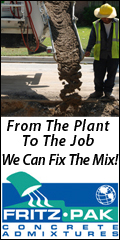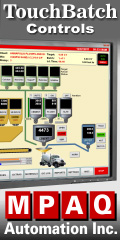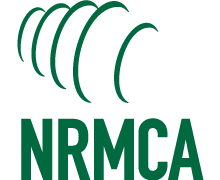
| Archive | nrmca.org | E-Store | Conferences & Events | Certifications | InFocus | Membership Directory |
NRMCA Attends ACI Spring 2013 Convention, Provides Updates on Committee Activity The ACI Spring Convention in Minneapolis was held last week. NRMCA staff attended and provides the following updates of some of activities that involved NRMCA representation.
130 – Sustainability Committee - The committee continues to struggle to publish a comprehensive guide on concrete sustainability. The large scope of the document, size of the committee, special interests and rapid movement of the green building movement are hampering the development of this document. NRMCA worked to develop chapters on materials, production and construction, each of which have been balloted and finalized. NRMCA will continue to work on the committee to ballot other chapters of the document. Lionel Lemay maintains representation on this committee.
132 – Responsibilities in Concrete Construction - The committee is in the final stages of completing its document on responsibilities in concrete construction that will be submitted through the ACI review process for approval. The committee discussed and assigned a task group for developing a document on responsibility on installation and testing of floor coverings on concrete slabs. The committee sponsored a Hot Topic Session on responsibility that included very interesting presentations from Jeff Coleman (Coleman Law Firm) who discussed the history of the development of the committee’s document, Julie Buffenbarger (Lafarge) on litigation associated with LEED projects, Casimir Bognacki on performance specifications implemented by this owner and the implications to responsibility (Port Authority NY/NJ), Kevin MacDonald (Beton Consulting) on the responsibility of mixture proportioning from the concrete suppliers' perspective and from Boyd Clark (CTLGroup) on forensic investigations and consulting services. Colin Lobo maintains representation on ACI 132.
201 – Durability - The 201.2R Guide to Durable Concrete is being revised. Chapters on Corrosion and Abrasion Resistance have been revised. Abrasion chapter includes discussion on pervious concrete. Karthik Obla maintains representation on ACI 201.
211 – Mixture Proportioning - The document Standard Practice for Selecting Proportions for Normal, Heavyweight, and Mass Concrete is being re-balloted. Comments from the ACI staff engineer on the new chapter on concrete mixture submittals have been addressed by the committee. This chapter includes examples of prescriptive and performance submittals. New task groups are working on mixture proportioning for pumping and mixture proportioning with ground limestone powder and mineral fillers which will be handled in separate sections. Karthik Obla maintains representation on ACI 211.
214 – Strength Tests - This committee is looking for project compressive strength test data to update the table showing the standards of concrete control for both testing variability as well as batch to batch variability. Karthik Obla is as an associate member and has been helping to collect strength test data from members.
232 – Fly Ash and Natural Pozzolans - The committee resolved most of the negatives on a new report on high volume fly ash (HVFA) concrete. There will be another short ballot in April following which the document can go to TAC. The committee is involved in responding to the TAC suggestions on ACI 232.2R, Use of Fly Ash in Concrete. A substantially revised ACI 232.1R, Use of Natural Pozzolans in Concrete, has been completed. Karthik Obla is the chair of ACI 232.
301 – Specifications for Structural Concrete - ACI Committee 301 is working on several revisions to the specification in this cycle. Resolutions of ballots have resulted in revisions to the sections on lightweight concrete, mass concrete, shrinkage compensating concrete, architectural concrete, reinforcement and tilt up concrete. In the sections on concrete materials, Section 4, committee revisions were approved to change requirements for slump to allow selection by the contractor among other aspects, to change the age of test records and other smaller but significant revisions that typically cause problems on projects.
The committee is also working on including requirements for alkali silica reactions. The committee will review developments in ACI 318 as the reorganized code is published, especially the new chapter on Construction Documents to ensure it properly covers requirements in the code. Committee-approved revisions do not assure they will appear in the final document because of the intervening review process. ACI 301 is working toward completing its revised specification by 2014 and will follow a tough schedule of bi-weekly conference calls to address ballots. Colin Lobo maintains representation on ACI 301
318 – Building Code for Structural Concrete - The committee continues its frantic pace of achieving consensus on a reorganized member-based code. The committee plans to complete this reorganized fode by Fall 2013, following which an ACI review process and public comments have to be addressed. The chapters on materials and associated commentary have been completed. Some code revisions that impact concrete materials include revisions to some of the defined durability exposure classifications and requirements to concrete, and to include reference to ASTM C595 on blended cement that permits up to 15% limestone.
Other minor changes are being proposed if the time and opportunity exists. The committee reiterated a decision that the 318 Code is written to the Licensed Design Professional and contractors have no responsibility for code requirements or to review requirements in the code. This is necessary as a new chapter on Construction Documents is being finalized with significant comments in previous balloting. Colin Lobo maintains representation on ACI 318.
325 – Concrete Pavements - The committee currently has five documents under development or revision. The report ACI 325.9R Guide for Construction of Concrete Pavements has been completely revised and the committee is currently responding to TAC comments. The committee has received tentative re-approval of ACI 325.12R-02: Guide for Design of Jointed Concrete Pavements for Streets and Local Roads which was revised by NRMCA's Brian Killingsworth, making U.S. Customary units as primary and corrected the design thickness tables, while also addressing a few editorial issues. A complete revision with updated thickness tables and other technical revisions will begin immediately and will be lead by Killingsworth.
The committee is developing ACI 325.XR Report on Precast Concrete Pavements - State of the Practice which is based upon work completed by Tayabji for SHRP2. The SHRP2 document has become the basis for an ACI design and construction report for precast and prestressed pavements which will be reviewed by the committee over the next few months. The committee is also developing ACI 325.YR Proportioning, Quality Control and Evaluation of Concrete Pavement Strength Relationships. The document is complete and is being prepared for balloting by the Fall 2013 Convention. A revision is underway of 325.11R Accelerated Techniques for Concrete Paving. Work is nearly complete and will be balloted in the next few months. The effort will harmonize with the proportioning document. Killingsworth will ensure that considerations for streets and local roads will be included in all documents. Brian Killingsworth maintains representation on ACI 325 on concrete pavements.
327 - Roller-Compacted Concrete Pavements - Brian Killingsworth will maintain representation on this committee. Current activities include resolving negative votes on the report ACI 327.XR Report on Roller-Compacted Concrete Pavements. The committee has also initiated development of an RCC specification for materials and construction to supplement report 327.XR.
329 – Performance Criteria for Materials for Ready Mixed Concrete - The committee reviewed the process for a new guide document on performance requirements for ready mixed concrete. It should be available as a Committee 329 report by Fall 2013. The committee will make a request TAC to develop a guide specification on performance requirements for concrete and with this development will suggest revisions to ACI 301 and 318 for future consideration. Some of NRMCA-developed recommendations to specifications will be used for this purpose. The committee is also developing a standard presentation discussing the benefits of evolving to performance-based specifications for improved quality and to support sustainable construction. Colin Lobo and Karthik Obla maintain representation on Committee 329.
330 – Parking Lots - In pursuit of the upcoming 330.XR Guide for the Design and Construction of Concrete Site Paving for Industrial Pavements and Trucking Facilities guide and specification, the ACI 330 Committee completed review of two more chapters, leaving just four remaining chapters to complete. These chapters will be reviewed and discussed prior to the fall ACI meeting with the goal to submit the entire document to Technical Action Committee (TAC) after that meeting. This document with be in addition to the existing ACI 330R-08 Guide to Design and Construction of Concrete Parking Lots. In addition to review and collaboration on comments, the group also heard a presentation from TC Pavements regarding its software on design of pavement sections utilizing shorter panels. Amy Miller maintains representation on Committee 522.
ACI 332 – Residential Concrete - The committee continues to work on finalizing the 2013 version of the Residential Code Requirements for Structural Concrete (ACI 332-13) and Commentary. At the urging of the ACI Technical Activities Committee (TAC), the committee has developed a section in the standard on concrete durability that follows closely the durability requirements of ACI-318, Building Code Requirements for Structural Concrete. NRMCA worked with other members of the committee to develop new definitions for durability classes specifically for residential concrete to address freezing and thawing, sulfate and chloride exposure. Despite a more complex process for identifying mixture requirements for residential concrete as a result, the requirements for concrete mixtures remain similar to past versions of the residential code. NRMCA is currently developing examples for the commentary to simplify the process of identifying concrete requirements. Public comments for the new standard will be issued in the next several months. Lionel Lemay maintains representation on this committee.
522 – Pervious Concrete - The committee discussed the upcoming ACI 522.1-12 Specification for Concrete Pervious Pavement document. This committee reviewed public comments at the prior ACI meeting and its response submitted to TAC. The committee continues to wait for TAC approval before the document can be published. The committee also passed a ballot for acceptance of standard details for pervious concrete pavements that will be a supplement to 522R and will be posted in the ACI Concrete Knowledge Center.
Various other subjects were discussed at the committee meeting, including an update from Dr. John Kevern, University of Missouri, on cost effective solutions for density testing, hydraulic design of pervious concrete shoulders, silica fume optimization in pervious concrete, use of pervious hollow core precast sidewalk panels, and curing results of polymers and lightweight aggregates. Jereme Montgomery, Nebraska Concrete and Aggregates Association, discussed his research on comparison of fresh versus hardened density tests. Dan Biddle, FORTA corporation, gave a presentation on use of macro-synthetic fibers in pervious.
Updates from various organizations were presented, including NRMCA, ASTM, ASCE, TRB and a presentation from Scott Erickson, incoming chair for National Pervious Concrete Pavement Association. Lastly, a new subcommittee was formed to look at creating specifications for non-pavement pervious concrete applications. Amy Miller maintains representation on Committee 522.
330 – Parking Lots - In pursuit of the upcoming 330.XR Guide for the Design and Construction of Concrete Site Paving for Industrial Pavements and Trucking Facilities guide and specification, the ACI 330 Committee completed review of two more chapters, leaving just four remaining chapters to complete. These chapters will be reviewed and discussed prior to the fall ACI meeting with the goal to submit the entire document to Technical Action Committee (TAC) after that meeting. This document with be in addition to the existing ACI 330R-08 Guide to Design and Construction of Concrete Parking Lots.
In addition to review and collaboration on comments, the group also heard a presentation from TC Pavements regarding its software on design of pavement sections utilizing shorter panels. Amy Miller maintains representation on Committee 522.
555 – Recycled Materials - Karthik Obla maintains representation on ACI 555. The document Removal and Reuse of Hardened Concrete is undergoing revisions and will include discussions on crushed returned concrete aggregates based on research work conducted at the NRMCA Research Laboratory. There will be two sessions on recycled materials in concrete and is likely to feature presentations by NRMCA engineers on wash water and crushed concrete aggregate.
Sessions - There were a number of sessions on green cements and fly ash in honor of Dick Stehly. ACI provides access to presentations made during the convention.
The U.S. Bureau of Reclamation presented some one-of-a-kind tests; the Bureau broke a 3 x 6 feet concrete cylinder in a 5 million lb. machine. It has a 1.25 cubic yard concrete mixer and made concrete with 3 in. aggregates; it did tension tests on 18 in. diameter cores; various concrete abrasion tests and shake table to see how dams hold up.
Other News
• ACI has developed a new disaster reconnaissance committee that will quickly survey disaster areas.
• An innovative task group has been developed for concrete wind turbine towers.
• Anne Ellis, with AECOM was elected as the incoming ACI president. Ms. Ellis worked at NRMCA as a promotion engineer in the 1990s.
• Colin Lobo, NRMCA, was presented with the Henry C. Turner medal "for the many contributions to the concrete industry through his work in ACI committees that have resulted in better concrete for pavement and structures".
|
|
|






